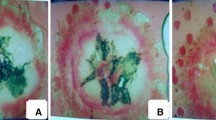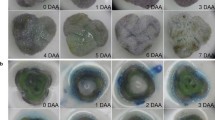Summary
The development and timing of different processes in the floral biology and sexual reproduction of Lilium longiflorum were studied and brought together into a chronological reproductive calendar. Care must be taken when emasculating flowers later than 4 days before anthesis (DBA), because the stomium of the anther was open from 8 DBA and the pollen grains appear to be mature from 3–2 DBA. The receptivity period of the pistil lasts for a rather long period, but before wilting of an unpollinated flower as determined by a change of the colour of the perianth from white into brown, the flower had already lost its receptivity. Because L. longiflorum pollen grains can easily be stored, the pistil receptivity should thus determine the pollination schedule. The relationships between pollen tubes and pistil are discussed with respect to plant breeding.
Similar content being viewed by others
Abbreviations
- DAA:
-
Days After Anthesis
- DAP:
-
Days After Pollination
- DBA:
-
Days Before Anthesis
References
Asano, Y., 1980. Studies on crosses between distantly related species of lilies. VI Pollen-tube growth in interspecific crosses of Lilium longiflorum. J. Japan. Soc. Hort. Sci. 49: 392–396.
Asano, Y. & H. Myodo, 1977. Studies on crosses between distantly related species of lilies. I. For the interstylar pollination technique. J. Japan. Soc. Hort. Sci. 46: 59–65.
Ascher, P.D. & S.J. Peloquin, 1968. Pollen tube growth and incompatibility following intra-and inter-specific pollinations in Lilium longiflorum. Am. J. Bot. 55: 1230–1234.
Breton, C., C. Said & C. Dumas, 1993. Cytological and biochemical calendar of ovule and seed development in Populus sp. J. Plant Physiol. 142: 331–337.
Brown, S.W. & M.S. Cave, 1953. Induced dominant lethality in Lilium. Proc. Natl. Acad. Sci. USA 39: 97–102.
Brown, S.W. & M.S. Cave, 1954. The detection and nature of dominant lethals in Lilium 1. Effects of X-rays on the heritable component and functional ability of the pollen grain. Am. J. Bot. 41: 455–469.
Gerlach, D., 1977. Botanische Mikrotechnik. Eine Einführung. p. 311 071 Georg Thieme Verlag, Stuttgart.
Erickson, R.O., 1948. Cytological and growth correlations in the flower bud and anther of Lilium longoflorum. Am. J. Bot. 35: 729–739.
Herr Jr., J.M., 1973. The use of Nomarski interference microscopy for the study of structural features in cleared ovules. Acta Bot. Indica 1: 35–40.
Janson, J., 1992. Pollen tube-pistil interaction and fertilization in Lilium longiflorum. Thesis. Agricultural University Wageningen. 145 p.
Janson, J., M.C. Reinders, A.G.M. Valkering, J.M. Van Tuyl & C.J. Keijzer, 1994. Pistil exudate production, embryo sac development, receptivity and pollen tube growth in Lilium longiflorum Thumb. Annals of Botany: 437–446.
Keijzer, C.J., 1987. The processes of anther dehiscence and pollen dispersal. 1. The opening mechanism of longitudinally dehiscing anthers. New Phytol. 105: 487–498.
Pacini, E. & G. Sarfatti, 1978. The reproductive calendar of Lycopersicum peruvianum Mill. Soc. Bot. Fr., Actualités botaniques 1–2: 295–299.
Sarker, R.H., M.A. Samad, Z.I. Seraj, M.I. Hoque & A.S. Islam, 1993. Pollen tube growth in crosses between Porteresia coarctata and Oryza sativa. Euphytica 69: 129–134.
Spurr, A.R., 1969. A low viscosity epoxy resin embedding medium for electron microscopy. J. Ultrastruct. Res. 71: 173–184.
Van Dort, J.B., J.P. Zeelen & W.C. de Bruin, 1983. X-Ray microanalytical detection of mouse kidney lysosomal acid phosphatase by Cerium in combination with various postfixations. Beitr. Elektronenmikroskop. Direktabb. Oberfl. 16: 389–392.
Van Tuyl, J.M., J. Franken, R.C. Jongerius, C.A.M. Lock & A.A.M. Kwakkenbos, 1986. Interspecific hybridization in Lilium. Acta Horticulturae 177: 591–595.
Van Tuyl, J.M., T.P. Straathof, R.J. Bino & A.A.M. Kwakkenbos, 1988. Effect of three pollination methods on embryo development and seedset in intra-and interspecific crosses between seven Lilium species. Sex. Plant Reprod. 1: 119–123.
Van Tuyl, J.M., M.P. Van Diën, M.G.M. Van Creij, T.C.M. Van Kleinwee, J. Franken & R.J. Bino, 1991. Application of in vitro pollination, ovary culture, ovule culture and embryo rescue for overcoming incongruity barriers in interspecific Lilium crosses. Plant Sci. 74: 115–126.
Van Went, J.L., N.M. Van Beek & J.M. Van Tuyl, 1985. Ovule development in relation to ovule position and flower development in Lilium. Proc. 8th Int. Symp. on Sexual Reprod. in Seed Plants, Ferns and Mosses. p. 135. Pudoc, Wageningen.
Williams, E.G., J.L. Rouse, V. Kaul & R.B. Knox, 1991. Reproductive timetable for the tropical Vireya rhododendron, R. macgregoriae. Sex. Plant Reprod. 4: 155–165.
Author information
Authors and Affiliations
Rights and permissions
About this article
Cite this article
Janson, J., Keijzer, C.J. & Reinders, M.C. A reproductive calendar of Lilium longiflorum Thunb. cv. Gelria. Euphytica 86, 25–29 (1995). https://doi.org/10.1007/BF00035935
Received:
Accepted:
Issue Date:
DOI: https://doi.org/10.1007/BF00035935




